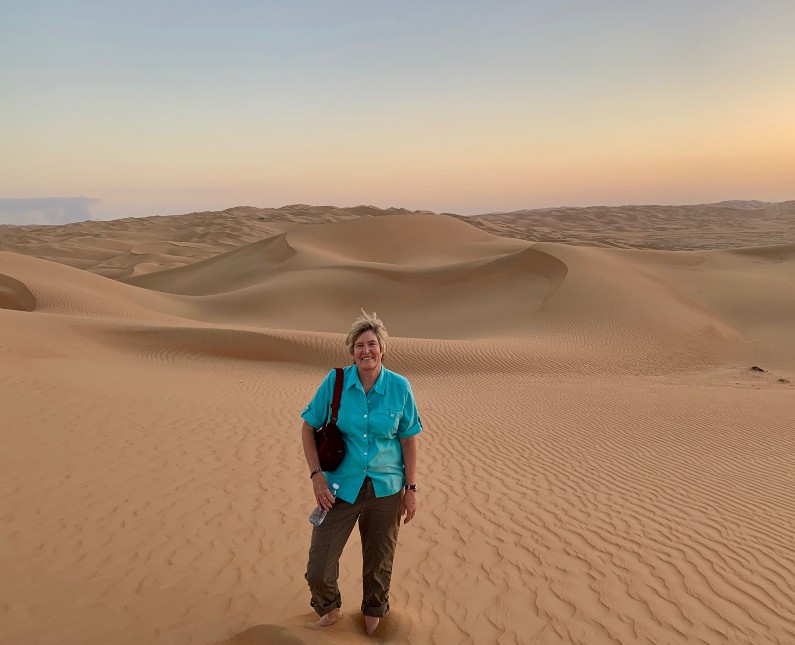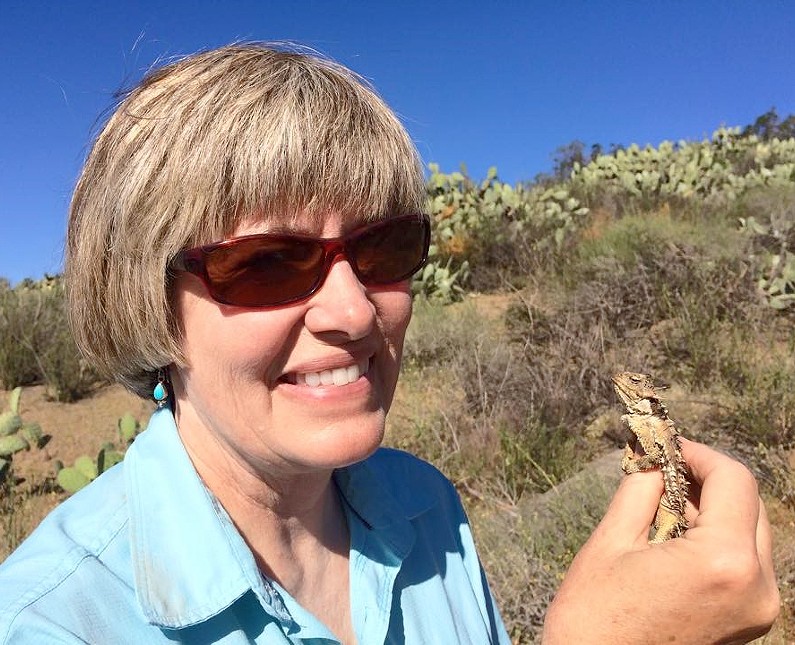Dr. Allison Alberts serves as one of eleven members comprising the Mohamed bin Zayed Species Conservation Fund’s Advisory Board. In this role, she specialises in evaluating grant proposals concerning lizards, snakes, and crocodilians. With a distinguished career spanning three decades at the San Diego Zoo, her passion for reptile conservation began in graduate school and has remained steadfast. Today, she brings her wealth of experience to identify and support the most promising projects in her field of expertise.
EDITOR Hello Dr Alberts, thank you for talking with us today.
ALLISON ALBERTS Thank you for having me, it’s my pleasure.
ED How long have you been part of the Fund, and what drew you to this position?
AA I was first invited to join the Fund’s Advisory Board in 2018, when I was serving as Chief Conservation and Research Officer at the San Diego Zoo. I was drawn to the Fund’s focus on species conservation, as well as its commitment to supporting early career conservationists working in their home countries to protect and restore endangered species and their habitats. When I spoke with others on the board, several members told me that serving the Fund as an advisor was one of the most fulfilling experiences of their career. I retired from the Zoo in 2020 but am still just as passionate about the Fund as I was when I first started, if not more so! I’ve seen first-hand the difference these awards can make in local communities helping people solve conservation challenges.
ED That sounds amazing, what sparked your passion for species conservation?
AA As a child, virtually all our family vacations involved camping and being outdoors. My parents were also tolerant of a small menagerie of animals in our home, including cats, rats, turtles, tadpoles, fish, butterflies, and brine shrimp. We lived near a park where local newts would undertake an annual breeding migration, and I remember being utterly fascinated by this phenomenon. I never lost my early love for and curiosity about nature, so when the biodiversity crisis came to the forefront in 1970s and 1980s, I knew I would spend my career working to prevent extinction.
ED I guess back then, it wasn’t at the forefront with many other political and social issues taking centerstage, whereas today it’s more prominent than ever.
AA Absolutely, it’s estimated that wildlife populations have plunged by an average of 69% between 1970 and 2018, but thanks to heightened conservation activities, we’re aiming to reverse the red.
ED What is your area of expertise, and how did you find yourself in this field?
AA My expertise is in designing and implementating species recovery programs, as well as conservation action planning. I’m a reptile and amphibian specialist, and have worked with endangered iguanas in Costa Rica, Cuba, the Turks and Caicos Islands, and Fiji, as well as Komodo dragons, sea turtles, desert tortoises, and native California plants, frogs, lizards, and snakes. For my doctoral research, I studied desert iguanas in southern California. After that, I shifted my focus to developing conservation strategies aimed at recovering critically endangered rock iguanas in the Caribbean. This eventually led to the creation of an IUCN Iguana Specialist Group and the establishment of the International Iguana Foundation, a non-profit dedicated to conserving these ancient and unique reptiles.
ED WOW, that’s amazing, you’ve worked on incredible species in some exotic locations.
AA It sounds more glamorous than it is, believe me, but making a difference to the IUCN conservation status of a species is incredibly rewarding.
ED In your view, what makes the Fund stand out from the rest?
AA To me, the Fund stands out for its ability to get species conservation funding into the hands of local people who can make a real difference in their communities. The Fund is unique in its flexibility to not only make grants to local organizations, but also to individual conservationists working on the ground. Because there is little to no overhead involved, the funding goes directly toward making a difference for species conservation. With its focus on understanding and addressing the threats facing threatened and data-deficient species, the Fund ensures that the species most in need receive attention. Finally, the Fund provides grants across the taxonomic spectrum. While many other funding opportunities focus only on charismatic mega-vertebrates, the Fund provides grants for everything from elephants and other vertebrates to tiny plants, insects, fungus, and even soil microbes.
ED Do you have any hobbies or interests outside of conservation?
AA I love gardening, especially succulents, and we grow a large variety of them at home. My favorites are the aloes because of the huge diversity of colorful flower stalks they produce. My husband Mike and I are both fascinated by ancient rock art and have traveled to many parts of the world to photograph petroglyphs and pictographs, including much of Africa, Australia, and North America. Finally, my dog Molly and I are a certified canine therapy team for Love on a Leash. We visit hospitals, schools, libraries, military bases, and other locations where people enjoy having the opportunity to interact with the dogs.
ED That’s incredibly motivating and sounds interesting, fun, and fulfilling. In terms of the Fund, what is the most inspiring project you’ve come across?
AA There are too many inspiring projects for me to choose only one! However, I will say that I’ve been very inspired by what my fellow advisor Dr. Jim Sanderson has been able to achieve for small cat conservation in collaboration with the Fund. He and his in-country colleagues have organized a Small Cat Working Group, with members from around the world. They coordinate their submission of proposals to the Fund in order to maximize their impact and serve as mentors to the “newbies” who are continually joining their ranks. Once they find a conservation solution that works, they can deploy it rapidly in new regions and as a result, small cat populations in many areas are now on the rise.
ED Amazing, it’s clear that collaboration is key to conservation success. What about the first project you ever recommended to the Fund?
AA My first Advisory Board meeting was in 2018 in Cornwall, England. I’d been told about the very competitive Chairman’s Awards that the Fund gives out, only two of which are granted each round, for the most exceptional projects. As a first-time reviewer, I thought it best to learn more about how this process worked before proposing one myself. However, my slate of proposals included one that was so compelling that two long-time advisory board members told me I simply had to put it forward for a Chairman’s Award. Despite my trepidation, I did so and was able to successfully recommend $25,000 to help conserve the critically endangered Galapagos pink iguana. No more than 200 individuals of this species remain on the slopes of an active volcano, and this grant was key to implementing a control program for the feral cats that prey on iguana hatchlings.
ED The Pink iguana sounds unique, and very much in need of conservation attention. Have you encountered any exceptional individuals since you’ve been advising the Fund?
AA Many of our grantees are exceptional, but there is one two-time grantee in my taxonomic area that stands out for me. Her name is Monica Torres, and she is a project director at the Foundation for the Endangered Species of Guatemala. She is working with the critically endangered Campbell’s alligator lizard, a pine-oak forest canopy specialist that relies on microhabitats created by bromeliads and orchids. She came to us with an innovative proposal last year to propagate bromeliads and transplant them onto native trees to create a more usable habitat for the species. She then followed up with another compelling proposal this year to track the lizard’s using radiotelemetry to prioritize areas for habitat protection and restoration. This multifaceted project has the potential to be a real conservation success story for Monica, her organization, and this species!
ED That’s incredible, she sounds like a species conservation superstar. Do you have any other memorable stories that come to mind?
AA MBZ Advisory Board meetings are one of the highlights of my year. Since I’ve been with the Fund, we’ve met in the UAE, the UK, Kenya, Sweden, France, the USA, Brazil, and Costa Rica. In recent years, the Fund has hosted gatherings for in-country conservationists, which has been a terrific opportunity to meet some of our wonderful grantees first-hand. For me, our meeting in Brazil’s Pantanal was especially memorable. Seeing jaguars in the wild for the first time and learning about the complexities of their coexistence with the local ranching community was inspiring and thought-provoking. I thoroughly enjoy spending time with my colleagues on the Advisory Board and I invariably learn so much every time we are together. I feel very honored to have the opportunity to help advise the Fund on a group of species that I care deeply about!
ED It’s been a fascinating interview and thank you for your time. If you can leave the audience with your conservation motto or mantra, what would that be?
AA Every species has found its own special way to be a successful living being on planet earth and represents an irreplaceable source of knowledge about strategies for survival. No matter how seemingly small or insignificant, each one is incredibly and uniquely valuable. As humans, we have an ethical obligation to ensure their continued existence.
ED That’s so true, we all have a part to play to make sure we save our planet for generations to enjoy. Thank you very much for your time, it’s been such a special experience.,
AA It’s my pleasure and I hope my experience will inspire others on their conservation journey.



